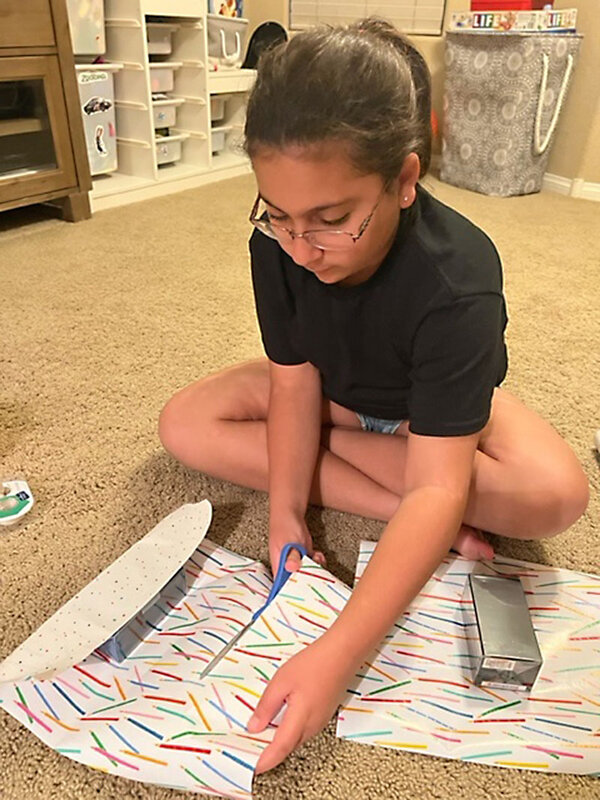Kids as cooks and dog walkers? How one elementary school encourages independence.
Loading...
| Las Vegas
Walking the dog. Wrapping a package. Cooking dinner.
For adults, these activities often represent mundane to-do list tasks. But for fifth graders in Las Vegas, they offered something different this past school year – a taste of independence.
“I can do things by myself more instead of having my dad or my mom do them,” says Deven Doutis, who learned his dog goes a little nuts when he spots another canine out for a stroll.
Why We Wrote This
A story focused onWhat does being independent look like for children? A school in Las Vegas encourages students to take on hobbies and activities on their own – in hopes of building more confidence and growth.
The small steps toward greater – and lasting – independence came about in a very intentional way. Deven’s teacher, Amy Wolfe, sensed students were entering higher grades with more needs than in past years. Some couldn’t open a water bottle, for instance, or navigate minor conflicts with their peers. So when Ms. Wolfe heard about a program called Let Grow, she decided to pilot it within select classrooms at Dennis Ortwein Elementary School in Las Vegas.
The program’s premise is simple: When children gain independence, they grow into more confident and capable people.
“Kids are kids, right?” she says. “They’re only going to do what they’ve been taught or what they’ve been allowed to do.”
But what, exactly, are kids allowed to do by themselves nowadays? Terms such as “helicopter parent” or “overparenting” have become shorthand to describe adults who are overly involved, sometimes to the detriment of their child’s developmental growth. While certainly not all parents fall into those categories, experts say a societal shift has led to a tighter leash being imposed on children.
A poll conducted last year for C.S. Mott Children’s Hospital at the University of Michigan found that three-quarters of parents say they have their children do things for themselves; however, the percentage of parents who report their children do specific activities independently is lower. Only a third of parents, for example, allow their 9-to-11-year-old child to walk or bike to a friend’s house. A similar portion say they encourage their 5-to-8-year-olds to decide how to spend their own gift or allowance money.
Safety concerns emerged as the top reason those same parents don’t allow their children more free rein. The results did not come as a surprise to Lenore Skenazy, president of Let Grow and author of “Free-Range Kids.” For years, she has been on a mission to unleash children in a society where they increasingly have little independence in the physical world. In 2008, she penned a column about letting her then-9-year-old son ride the subway by himself. It horrified some readers.
She says the backlash stems from a pervasive, heightened sense of danger built by media narratives and litigious tendencies.
“It’s just a culture that rewards excessive fantasizing about danger,” Ms. Skenazy says. “And that has become so common that it doesn’t feel like a fantasy anymore. It just feels like prudence.”
In a commentary piece published by The Journal of Pediatrics last year, researchers pointed to evidence showing a correlation between children’s dwindling independence and increasing mental health problems over several decades.
“We are not suggesting that a decline in opportunities for independent activity is the sole cause of the decline in young people’s mental well-being over decades, only that it is a cause, possibly a major cause,” the authors wrote. (The lead author, Peter Gray, is a research professor in psychology at Boston College and a founding member of Let Grow.)
In Ms. Wolfe’s classroom each month, students chose an independent activity, loosely tied to a theme, and completed it by themselves. Then they reported back to their classmates and teacher about the experience. There were no grades or critiques. If Ms. Wolfe asked any probing questions, it was to suss out how her students felt after, say, baking a cake or pulling weeds.
Her hope is that their newfound confidence carries into the academic realm, especially considering the American education system is built around increasing independence through elementary, middle, and high school.
“It’s more about developing the conversations with students to where they see independence ... as a value,” she says.
Schools can be a part of a “collective solution,” Ms. Skenazy says. Rather than feeling alone in granting their children independence, parents will be doing it together and seeing the benefits.
For her first project, Giwan Istefan’s 11-year-old daughter, Aria, decided to make miniature lemon-and-blueberry cheesecakes. Ms. Istefan says it turned into an exercise in parental restraint as well.
“I was like, ‘Oh my gosh, I see the disaster happening,’” she says. “But I had to step back. It was growth not just for her, but it was growth for also myself.”
Even so, Ms. Istefan says she supports the idea of fostering more independence among children. She remembers playing outside as a child until the streetlights turned on. Nowadays, she sees kids engrossed in their electronics, playing video games or endlessly watching YouTube videos. She hasn’t allowed her daughter – a fifth grader this past year at Ortwein Elementary School – to have a cellphone yet for that reason.
She worries about the long-term ramifications if younger generations aren’t forced outside their technology bubbles.
With summer starting, Ms. Skenazy encourages parents to set aside unstructured playtime for their children. Maybe neighbors could band together, she says, and leave Friday afternoons open for their children to play outside.
Parker Poelma, another recent fifth grader at Ortwein Elementary, discovered a new outdoor hobby through the project. He finally decided to give skateboarding a try – even if it initially meant falling off multiple times.
His takeaway: “I am surprisingly tougher than I thought.”







